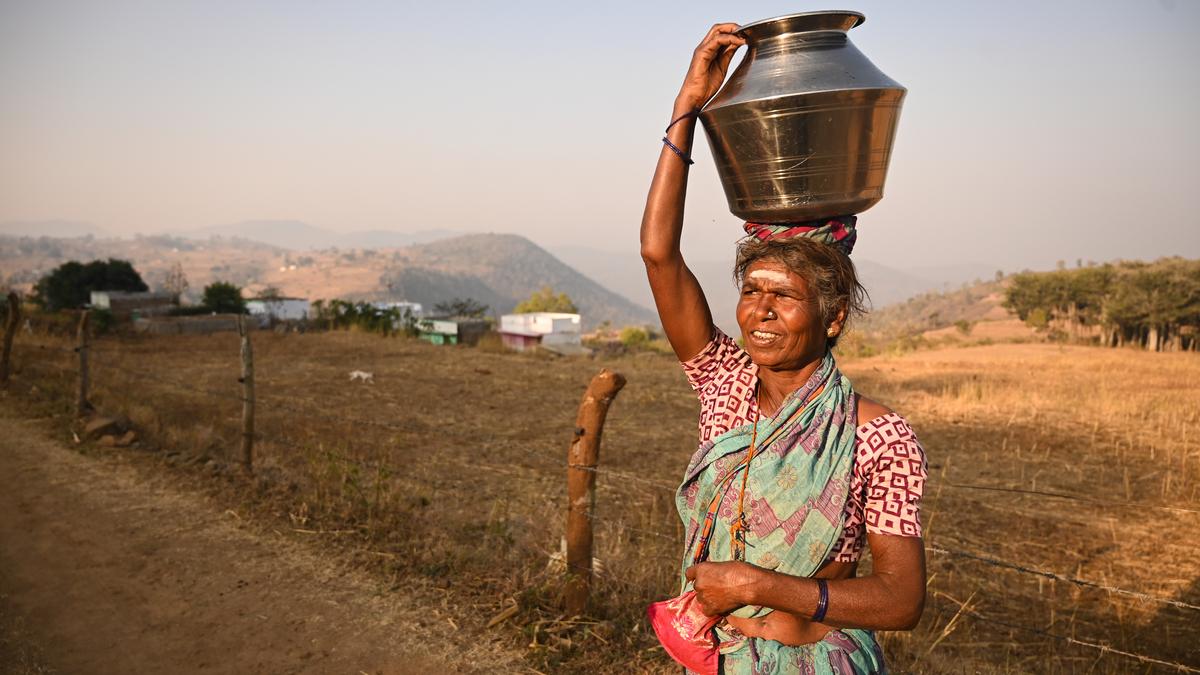
The Public Well Revival Movement wants people in Tamil Nadu to reconnect with the ancient sustainable source of drinking water Premium
The Hindu
Reviving defunct wells in Tamil Nadu's mountain villages empowers women and communities, connecting people to sustainable water sources.
We trek up a trail, on a hillock composed of damp, loose rock that cuts into finger millet fields, to reach Giri’s tile-roofed home. It is within the many folds of Erode district’s Bargur hills of the Western Ghats in Tamil Nadu. He is not home, but his goats are. “Women walk up this stretch with a pot of water balanced on their hips up to 10 times a day,” points out Madhu Manjari Selvaraj when we pause to catch our breaths near the goat shed. The world over, it is women who take it upon themselves to fetch water. It is no different in the mountain village of Solakanai.
Here, women walk to a mountain stream for water every day. A few metres from the stream is their village well that, until a few months ago, was covered with boulders and sediment. It now brims with water and the promise of a new beginning after Manjari and her team from the Public Well Revival Movement took it into their fold. A handful of men used rocks sourced from the nearby hills to build a wall against the flow of the stream, after which the well was dredged, with a wall constructed around it. It was opened last month.
The initiative, an off-shoot of the Tamil Nadu-based Cuckoo Movement for Children, which strives to make childhood meaningful, has revived 15 defunct wells across the state over the past four years with crowd-funding. It is helmed by Manjari and her team that includes M. Mari Muthu, K. Rahuraman, V. Muthu, C. Bala Gurunathan, A. Arun Kumar and S. Mohan. Manjari, an architect, recently won the Doshi We Know Fellowship 2024-25 for her work.
“Wells become unusable for various reasons,” says Manjari. “They may be closed due to conflicts arising out of caste tensions; due to sand or rock filling them up over the years or simply because people have forgotten their existence owing to piped water connections.”
But the earth remembers. Despite being forgotten, water continues to spring forth from a well. The Public Well Revival Movement identifies such wells, reminding people in the village or town of its existence. After necessary permissions from local authorities, citizen’s collectives, and the Forest Department are sought, it sets out to revive them with help from the locals themselves.
Wells, says Manjari, are sustainable sources of water. While waterbodies such as ponds and lakes provide surface water, wells store groundwater and are hence able to keep regenerating. “A well connects four to five aquifers,” she points out.
The first well the group dredged was in Puliyanur village near Tiruvannamalai. The team that usually camps in local government schools or temples spent almost three months in Puliyanur. At the end of the first month, they saw the first traces of clear water. The sun’s reflection gleamed gold in it: it was a moment that filled the team with immense faith in their movement. It soon filled up and the villagers came to it in droves, pots in hand, unable to believe their dilapidated well was alive.

When reporters brought to her notice the claim by villagers that the late maharaja of Mysore Sri Jayachamaraja Wadiyar had gifted the land to them, Pramoda Devi Wadiyar said she is not aware of the matter, but sought to assure people that no effort will be made to take back the land that had been gifted by the late maharaja.





















 Run 3 Space | Play Space Running Game
Run 3 Space | Play Space Running Game Traffic Jam 3D | Online Racing Game
Traffic Jam 3D | Online Racing Game Duck Hunt | Play Old Classic Game
Duck Hunt | Play Old Classic Game










